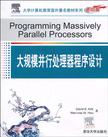大规模并行处理器程序设计
出版时间:2010-7 出版社:清华大学出版社 作者:(美)柯克 等著 页数:258
Tag标签:无
前言
Mass-market computing systems that combine multicore CPUs and many-core GPUs have brought terascale computing to the laptop and petascalecomputing to clusters. Armed with such computing power, we are at thedawn of pervasive use of computational experiments for science, engineer-ing, health, and business disciplines. Many will be able to achieve break-throughs in their disciplines using computational experiments that are ofunprecedented level of scale, controllability, and observability. This bookprovides a critical ingredient for the vision: teaching parallel programmingto millions of graduate and undergraduate students so that computationalthinking and parallel programming skills will be as pervasive as calculus. We started with a course now known as ECE498AL. During the Christ-mas holiday of 2006, we were frantically working on the lecture slides andlab assignments. David was working the system trying to pull the earlyGeForce 8800 GTX GPU cards from customer shipments to Illinois, whichwould not succeed until a few weeks after the semester began. It alsobecame clear that CUDA would not become public until a few weeks afterthe start of the semester. We had to work out the legal agreements so thatwe can offer the course to students under NDA for the first few weeks.We also needed to get the words out so that students would sign up sincethe course was not announced until after the preenrollment period.
内容概要
本书介绍了并行程序设计与GPU体系结构的基本概念,并详细探讨了用于构建并行程序的各种技术,用案例演示了并行程序设计的整个开发过程,即从并行计算的思想开始,直到最终实现实际且高效的并行程序。 本书特点 介绍了并行计算的思想,使得读者可以把这种问题的思考方式渗透到高性能并行计算中去。 介绍了CUDA的使用,CUDA是NVIDIA公司专门为大规模并行环境创建的一种软件开发工具。 介绍如何使用CUDA编程模式和OpenCL来获得高性能和高可靠性。
作者简介
作者:(美国)柯克(David B.Kirk) (美国)Wen-mei W.Hwu
书籍目录
PrefaceAcknowledgmentsDedicationCHAPTER 1 INTRODUCTION 1.1 GPUs as Parallel Computers 1.2 Architecture of a Modern GPU 1.3 Why More Speed or Parallelism? 1.4 Parallel Programming Languages and Models 1.5 Overarching Goals 1.6 Organization of the BookCHAPTER 2 HISTORY OF GPU COMPUTING 2.1 Evolution of Graphics pipelines 2.1.1 The Era of Fixed-Function Graphics Pipelines 2.1.2 Evolution of Programmable Real-Time Graphics 2.1.3 Unified Graphics and Computing Processors 2.1.4 GPGPU: An Intermediate Step 2.2 GPU Computing 2.2.1 Scalable GPUs 2.2.2 Recent Developments 2.3 Future TrendsCHAPTER 3 INTRODUCTION TO CUDA 3.1 Data Parallelism 3.2 CUDA Program Structure 3.3 A Matrix-Matrix Multiplication Example 3.4 Device Memories and Data Transfer 3.5 Kernel Functions and Threading 3.6 Summary 3.6.1 Function declarations 3.6.2 Kernel launch 3.6.3 Predefined variables 3.6.4 Runtime APlCHAPTER 4 CUDA THREADS 4.1 CUDA Thread Organization 4.2 Using b]ockldx and threadIdx 4.3 Synchronization and Transparent Scalability 4.4 Thread Assignment 4.5 Thread Scheduling and Latency Tolerance 4.6 Summary 4.7 ExercisesCHAPTER 5 CUDATM MEMORIES 5.1 Importance of Memory Access Efficiency 5.2 CUDA Device Memory Types 5.3 A Strategy for Reducing Global Memory Traffic 5.4 Memory as a Limiting Factor to Parallelism 5.5 Summary 5.6 ExercisesCHAPTER 6 PERFORMANCE CONSIDERATIONS 6.1 More on Thread Execution 6.2 Global Memory Bandwidth 6.3 Dynamic Partitioning of SM Resources 6.4 Data Prefetching 6.5 Instruction Mix 6.6 Thread Granularity 6.7 Measured Performance and Summary 6.8 ExercisesCHAPTER 7 FLOATING POINT CONSIDERATIONS 7.1 Floating-Point Format 7.1.1 Normalized Representation of M 7.1.2 Excess Encoding of E 7.2 Representable Numbers 7.3 Special Bit Patterns and Precision 7.4 Arithmetic Accuracy and Rounding 7.5 Algorithm Considerations 7.6 Summary 7.7 ExercisesCHAPTER 8 APPLICATION CASE STUDY: ADVANCED MRI RECONSTRUCTION 8.1 Application Background 8.2 Iterative Reconstruction 8.3 Computing FHd Step 1. Determine the Kernel Parallelism Structure Step 2. Getting Around the Memory Bandwidth Limitation. Step 3. Using Hardware Trigonometry Functions Step 4. Experimental Performance Tuning 8.4 Final Evaluation 8.5 ExercisesCHAPTER 9 APPLICATION CASE STUDY: MOLECULAR VISUALIZATION AND ANALYSISCHAPTER 10 PARALLEL PROGRAMMING AND COMPUTATIONAL THINKINGCHAPTER 11 A BRIEF INTRODUCTION TO OPENCLTMCHAPTER 12 CONCLUSION AND'FuTuRE OUTLOOKAPPENDIX A MATRIX MULTIPLICATION HOST-ONLY VERSION SOURCE CODEAPPENDIX B GPU COMPUTE CAPABILITIESIndex
章节摘录
插图:The raster operation (ROP) stage in Figure 2.2 performs the final rasteroperations on the pixels. It performs color raster operations that blend thecolor of overlapping/adjacent objects for transparency and antialiasingeffects. It also determines the visible objects for a given viewpoint anddiscards the occluded pixels. A pixel becomes occluded when it is blockedby pixels from other objects according to the given view point. Figure 2.3 illustrates antialiasing, one of the ROP stage operations.Notice the three adjacent triangles with a black background. In the aliasedoutput, each pixel assumes the color of one of the objects or the back-ground. The limited resolution makes the edges look crooked and theshapes of the objects distorted. The problem is that many pixels are partlyin one object and partly in another object or the background. Forcing thesepixels to assume the color of one of the objects introduces distortion intothe edges of the objects. The antialiasing operation gives each pixel a colorthat is blended, or linearly combined, from the colors of all the objects andbackground that partially overlap the pixel. The contribution of each objectt the color of the pixel is the amount of the pixel that the object overlaps. Finally, the frame buffer interface (FBI) stage in Figure 2.1 managesmemory reads from and writes to the display frame buffer memory.
图书封面
图书标签Tags
无
评论、评分、阅读与下载
用户评论 (总计8条)
- 介绍的内容比较宽泛,稍微看看是会有些帮助的,不知道cude以后会则么样?
- 感觉写得不错
- 以后用的着,就买了,还没看
- 有一定的覆盖面,但具体算法实现较少涉及。
- 基本的入门书,讲原理比较清楚。
- 入门确实非常好,讲解很详细,内容也丰富。不过有个别小错误
- 挺好的书,必须看英文版,别看中文版的没意思。
- 赞美卓越,赞美快递,赞美好书!
相关图书
- Photoshop CS5数码照片处理与特效制作200技
- 大学计算机基础
- 单片机实用技术与应用
- 计算机图形图像制作
- 软件安全
- UG计算机辅助设计
- 完全掌握Windows 7超级手册
- 中文版3ds Max 2010完全学习手册
- Adobe Photoshop CS4技术圣经
- 中文版AutoCAD 2010完全自学手册
- 开发安全可靠的ASP.NET 3.5应用程序
- Pro/E Wildfire 4.0二次开发实例解析
- 中文版AutoCAD 2010建筑图形设计
- AutoCAD 2010中文版电气设计基础教程
- 中文版AutoCAD 2010室内装潢设计
- 中文版AutoCAD 2010电气设计
- 精通AutoCAD 2010中文版
- 英语教师用书3
- 全新大学俄语泛读教程
- 全新大学俄语教学参考书
- 全明星英语
- 英语·第3册
- 基础日语综合教程1(练习册)
- 英美散文名篇选读
- 这样复习阅读理解最有效
